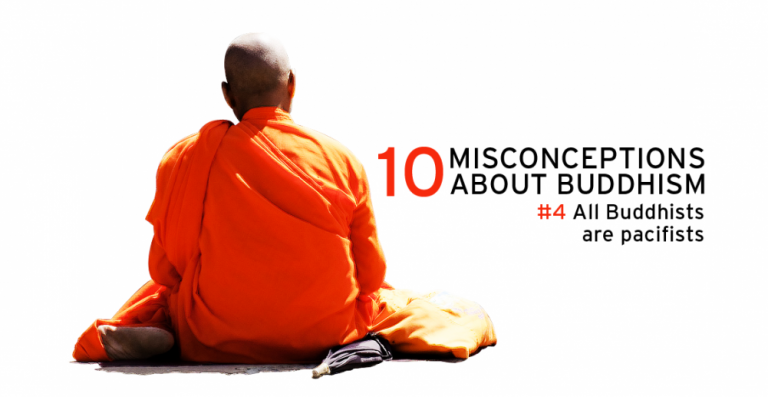One sometimes hears people say, “A war has never been fought in the name of Buddhism.” Exactly what “in the name of Buddhism” means is debatable. Not debatable is that Buddhists over the centuries have engaged in violent acts, including warfare, and have also condoned such acts.
In the 20th century, Tibetan monks took up arms and fought bravely against the Chinese troops of the People’s Liberation Army. Earlier in the century, they had fought against British invaders; troops of the Younghusband expedition took protective amulets, pierced by bullets, off the bodies of the Tibetan dead.
In Japan, during the Second World War, Buddhist monks, especially those of the Soto Zen sect, supported the aggression of Japanese troops in China and Korea. In previous centuries, many Japanese monasteries had their own armies, called sohei, made up of professional soldiers who wore monks’ robes but were not ordained, changing into their armor when it was time to fight, often against rival Buddhist armies.
Related: Buddhist Nationalism in Burma
Buddhism, like other world religions, has its own justifications for violence. The great chronicle of Sri Lanka, the Mahavamsa, tells the story of King Dutthagamani, who led his troops into battle against the Hindu Tamils who occupied the island. Dutthagamani himself killed the Tamil king in battle using a spear adorned with a relic of the Buddha. He then plunged the spear into the ground and ordered that a stupa be built over it. As a Buddhist, Dutthagamani was troubled by the carnage he had wrought, with tens of thousands of the enemy lying dead on the battlefield. He called in a group of arhats (enlightened monks) to calculate the negative karma he had accrued by so many acts of murder. They explained that he was guilty of killing only one-and-a-half people. Among the enemy dead was one person who had taken refuge in the three jewels of the Buddha, dharma, and sangha and had taken the five precepts of a Buddhist lay disciple (upasaka). He counted as one person. Another of the dead had only taken the refuges but not the precepts, and so counted as half a person. The rest were not people, so the king accrued no negative karma for their deaths.
Buddhism has been supported by all manner of kings and emperors over its long history. One of their motivations for doing so was to protect their lands from invaders. Huguo Fojiao, or “state protection Buddhism”—the idea that by supporting the community of monks and nuns, a kind of religious force field would guard the kingdom from harm—is a central theme of East Asian Buddhism. The first Zen text written in Japan, by the monk Myoan Eisai, was entitled “Promoting Zen in Defense of the State” (Kozen gokokuron). And perhaps the most famous of the Chinese Buddhist apocrypha (texts written in China that purport to be of Indian origin), the Renwang Jing (“Scripture for Humane Kings”), is devoted in part to the theme of state protection.
In some cases, the protection does not work, leading to dreams of revenge. The Kalacakra Tantra predicts that in the future, a great Buddhist army will sweep down from the Himalayas to defeat the barbarians who had driven the dharma from India long ago. These barbarians are followers of someone called Madhumati, an Indian attempt to render into Sanskrit the name Muhammad.
Related: Voices from Inside the Rohingya Refugee Camps
Violence in Buddhism is not always committed by physical means. In tantric Buddhism, so-called “liberation” rites are performed to liberate (that is, kill) one’s enemies. The great Tibetan translator Ra Lotsawa used such rites to murder the son of Marpa, the teacher of Milarepa. Farther east, when Korea was facing an invasion from Tang China in 670, the Korean thaumaturge Myongnang used powerful spells (mantra) he received from the undersea Dragon King protector of Buddhism to generate a typhoon that would sink the Chinese flotilla. (It worked.) When the Japanese invaded China in what would become the Second World War, the Chinese invited the Panchen Lama to come to China and perform tantric rituals in order to repel the invaders. (It didn’t work.)
[This story was first published in 2014]
Thank you for subscribing to Tricycle! As a nonprofit, we depend on readers like you to keep Buddhist teachings and practices widely available.
